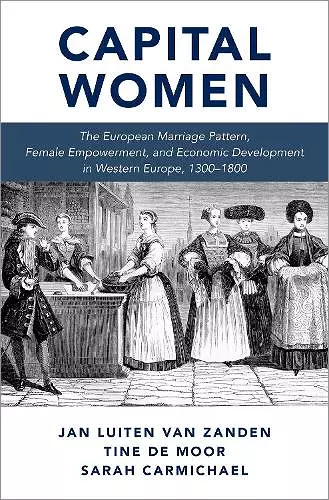Capital Women
The European Marriage Pattern, Female Empowerment and Economic Development in Western Europe 1300-1800
Tine De Moor author Jan Luiten van Zanden author Sarah Carmichael author
Format:Hardback
Publisher:Oxford University Press Inc
Published:11th Apr '19
Currently unavailable, and unfortunately no date known when it will be back

How women increasingly became economic agents in early modern Europe is the focus of this stimulating book, which highlights how female agency was crucial for understanding the development of the Western European economy and sheds light on economic development today. Jan Luiten van Zanden, Tine De Moor and Sarah Carmichael argue that over centuries a "European Marriage Pattern" developed, characterized by high numbers of singles among men and women, high marriage ages among men and women, and neolocality, where the couple forms a new nuclear household and did not co-reside with the parents of either bride or groom. This was due to the influence of the Catholic Church's teachings of marriage based on consensus, the rise of labor markets, and institutions concerning property transfers between generations that enhanced wage labor by women. Over time an unprecedented demographic regime was created and embedded in a highly commercial environment in which households interacted frequently with labor, capital and commodity markets. This was one of the main causes of the gradual move away from a Malthusian state towards an economy able to generate long-term economic growth. The authors explore how the pattern was influenced by and influenced female human capital formation, access to the capital market, and participation in the labor market. They use numerous measures of economic activity, including the unique "Girlpower-Index" that measures the average age at first marriage of women minus the spousal age gap, with higher absolute age at marriage and lower spousal age gap both indicating greater female agency and autonomy. The book also examines how this measure can increase understanding of contemporary dynamics of women and the economy. The authors thus shed light on the degree to which women are allowed to play an influential role in and on the economy and society, which varies greatly from one society to another.
Women matter! Capital Women is a strong and compelling book. It will be of the upmost interest for all those who wish to understand the ongoing debate about the historical role played by women in economic growth, progress, and development in Western Europe. * Claude Diebolt, CNRS Research Professor of Economics at the University of Strasbourg *
Development economists have long argued that if free to act for themselves and their families, women can contribute to growth and development; indeed the need to empower women has become a staple of development policy. Capital Women will help economic historians get up to date in understanding how women's agency can be seen as crucial to the development of Western Europe. Jan Luiten van Zanden, Tine De Moor, and Sarah Carmichael use a wide range of measures of economic activity, including their original "Girlpower-Index", to measure female agency and autonomy and then link these to the dynamics of development. Capital Women brings "Girlpower" into the economic historians' mainstream. * Jane Humphries, Centennial Professor, London School of Economics and Emeritus Professor of Economic History, Oxford University *
This book addresses from new angles the old debate on the origins, the characteristics and the consequences of the European Marriage Pattern. It makes a very substantial and timely contribution to our knowledge of preindustrial societies - and it will surely inspire research and solicit debate for years to come. * Guido Alfani, Bocconi University *
ISBN: 9780190847883
Dimensions: 236mm x 155mm x 28mm
Weight: 544g
304 pages